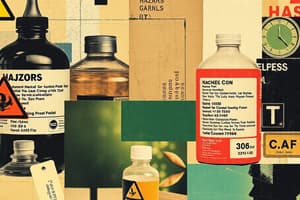Podcast
Questions and Answers
What must labels provide to chemical users?
What must labels provide to chemical users?
- Instructions on how to handle chemicals (correct)
- Marketing information about products
- Financial information about chemicals
- Discounts on chemical purchases
What is a limitation of chemical labels?
What is a limitation of chemical labels?
- They provide more details than Safety Data Sheets
- They cannot be affixed to containers
- They are restricted in the amount of information provided (correct)
- They can only be used for non-hazardous chemicals
Which of the following is NOT a required element on chemical labels?
Which of the following is NOT a required element on chemical labels?
- Hazard statement
- Signal word
- Expiration date (correct)
- Pictogram
What are the two signal words used on chemical labels?
What are the two signal words used on chemical labels?
What is the purpose of Safety Data Sheets (SDSs)?
What is the purpose of Safety Data Sheets (SDSs)?
Who is responsible for ensuring that hazardous chemical containers are labeled?
Who is responsible for ensuring that hazardous chemical containers are labeled?
What kind of information does a label typically NOT include?
What kind of information does a label typically NOT include?
What must workplace labels meet if employers choose to create their own?
What must workplace labels meet if employers choose to create their own?
If hazardous chemicals are transferred to a portable container for immediate use, what labeling is required?
If hazardous chemicals are transferred to a portable container for immediate use, what labeling is required?
What must employers ensure about their employees regarding the hazards of chemicals used?
What must employers ensure about their employees regarding the hazards of chemicals used?
What can a workplace labeling system include?
What can a workplace labeling system include?
What is the purpose of pictograms on labels?
What is the purpose of pictograms on labels?
Which statement about the labeling system using NFPA or HMIS is true?
Which statement about the labeling system using NFPA or HMIS is true?
What determines the required pictograms and hazard statements on a label?
What determines the required pictograms and hazard statements on a label?
What must an employer do if using their own labeling system?
What must an employer do if using their own labeling system?
Which of the following is NOT a required part of chemical labels?
Which of the following is NOT a required part of chemical labels?
Which precautionary statement should be included to prevent exposure to heat or flames?
Which precautionary statement should be included to prevent exposure to heat or flames?
What type of pictogram is used to indicate personal protective equipment needs?
What type of pictogram is used to indicate personal protective equipment needs?
Which of the following is NOT a type of supplementary information?
Which of the following is NOT a type of supplementary information?
What framing shape is used for pictograms that communicate chemical hazards?
What framing shape is used for pictograms that communicate chemical hazards?
What is the consequence of using a pictogram without a hazard symbol?
What is the consequence of using a pictogram without a hazard symbol?
Which of these must always be shown when multiple hazard statements are present?
Which of these must always be shown when multiple hazard statements are present?
In which self-reactive hazard categories do the precautionary statements apply?
In which self-reactive hazard categories do the precautionary statements apply?
What is a key requirement for the label of hazardous chemicals during transport?
What is a key requirement for the label of hazardous chemicals during transport?
Which precautionary statement emphasizes safe storage away from inappropriate materials?
Which precautionary statement emphasizes safe storage away from inappropriate materials?
What is the signal word used on the label for OXI252?
What is the signal word used on the label for OXI252?
What type of protective gear is recommended when handling OXI252?
What type of protective gear is recommended when handling OXI252?
What should be done with the contents or container after using OXI252?
What should be done with the contents or container after using OXI252?
What is a consequence of exposure to OXI252 as listed on its label?
What is a consequence of exposure to OXI252 as listed on its label?
Which precaution should be taken to prevent accidents when using OXI252?
Which precaution should be taken to prevent accidents when using OXI252?
What classification is given to the substance based on oral toxicity?
What classification is given to the substance based on oral toxicity?
What is the recommended action if the substance is swallowed?
What is the recommended action if the substance is swallowed?
Which signal word is used on the label?
Which signal word is used on the label?
What is included in the hazard statements of the label?
What is included in the hazard statements of the label?
What is the first step in responding to exposure to the substance?
What is the first step in responding to exposure to the substance?
What should you do after handling the substance?
What should you do after handling the substance?
What type of pictogram is mentioned for labeling?
What type of pictogram is mentioned for labeling?
What is the recommended disposal method for the container?
What is the recommended disposal method for the container?
What information is provided about the manufacturer?
What information is provided about the manufacturer?
Which action should not be taken when using this product?
Which action should not be taken when using this product?
Flashcards
Chemical Label
Chemical Label
A set of instructions for how to handle a hazardous chemical, including safety measures and emergency procedures.
Hazard Communication Standard (HCS)
Hazard Communication Standard (HCS)
A standardized system used to communicate hazards associated with chemicals, ensuring workers are informed about potential risks.
Safety Data Sheet (SDS)
Safety Data Sheet (SDS)
A document that provides comprehensive information about the hazards of a chemical, its properties, and how to handle it safely.
Signal Word
Signal Word
Signup and view all the flashcards
Pictograms
Pictograms
Signup and view all the flashcards
Hazard Statement
Hazard Statement
Signup and view all the flashcards
Precautionary Statement
Precautionary Statement
Signup and view all the flashcards
Pictogram Appearance
Pictogram Appearance
Signup and view all the flashcards
Most Stringent Precautionary Statements
Most Stringent Precautionary Statements
Signup and view all the flashcards
Supplementary Information
Supplementary Information
Signup and view all the flashcards
PPE
PPE
Signup and view all the flashcards
HMIS
HMIS
Signup and view all the flashcards
Self-Reactive Chemicals
Self-Reactive Chemicals
Signup and view all the flashcards
Order of Precedence
Order of Precedence
Signup and view all the flashcards
Acute Oral Toxicity
Acute Oral Toxicity
Signup and view all the flashcards
Category 4 (Acute Oral Toxicity)
Category 4 (Acute Oral Toxicity)
Signup and view all the flashcards
Safety Label
Safety Label
Signup and view all the flashcards
First Aid Information
First Aid Information
Signup and view all the flashcards
Disposal Instructions
Disposal Instructions
Signup and view all the flashcards
Batch Number
Batch Number
Signup and view all the flashcards
Manufacturer Information
Manufacturer Information
Signup and view all the flashcards
What is a pictogram?
What is a pictogram?
Signup and view all the flashcards
What is/are hazard statement(s)?
What is/are hazard statement(s)?
Signup and view all the flashcards
What are precautionary statements?
What are precautionary statements?
Signup and view all the flashcards
What is a signal word?
What is a signal word?
Signup and view all the flashcards
What are safety goggles?
What are safety goggles?
Signup and view all the flashcards
Workplace labeling system
Workplace labeling system
Signup and view all the flashcards
Employee awareness of chemical hazards
Employee awareness of chemical hazards
Signup and view all the flashcards
Workplace labeling system requirements
Workplace labeling system requirements
Signup and view all the flashcards
Portable container labeling
Portable container labeling
Signup and view all the flashcards
Creating a workplace label
Creating a workplace label
Signup and view all the flashcards
Workplace label content
Workplace label content
Signup and view all the flashcards
Workplace label location and requirements
Workplace label location and requirements
Signup and view all the flashcards
Workplace label communication methods
Workplace label communication methods
Signup and view all the flashcards
Training for NFPA/HMIS labeling
Training for NFPA/HMIS labeling
Signup and view all the flashcards
Continuing to use an existing labeling system
Continuing to use an existing labeling system
Signup and view all the flashcards
Study Notes
Hazard Communication Standard: Labels and Pictograms
- OSHA adopted new hazardous chemical labeling requirements aligned with the Globally Harmonized System of Classification and Labeling of Chemicals (GHS)
- The revised Hazard Communication Standard (HCS) transitioned from a performance-based standard to a standard with structured labeling requirements
- Labels must include pictograms, signal words, hazard, and precautionary statements for hazardous chemicals shipped after June 1, 2015
- Manufacturers, importers, and distributors can use the new labeling system before June 1, 2015
- Containers labeled by manufacturers or importers can be shipped by distributors (but not labeled by distributors) until December 1, 2015
- Labels contain name, address, telephone number, product identifier, signal words, hazard statements, precautionary statements, and pictograms
- Signal words ("Danger" or "Warning") indicate hazard severity. "Danger" is higher risk
- Hazard statements describe chemical hazards
- Precautionary statements give instructions for minimizing or preventing chemical exposure. This includes prevention, response, storage, and disposal procedures.
- Pictograms are graphic symbols used to identify chemical hazards. OSHA will enforce the use of 8 out of 9 GHS pictograms
- Safety Data Sheets (SDSs) provide detailed information on hazardous chemicals
- Employers are responsible for maintaining labels on containers and preventing them from becoming illegible or damaged
- Workplace labels can be created by employers and can include information from the SDS such as hazard, precaution, or additional instructions for use
- OSHA pictograms do not replace DOT requirements for shipping packaging
- Supplementary information about hazards not covered may appear on labels
- The new standard aims to improve worker comprehension, consistency, and safety when handling hazardous chemicals.
Studying That Suits You
Use AI to generate personalized quizzes and flashcards to suit your learning preferences.




